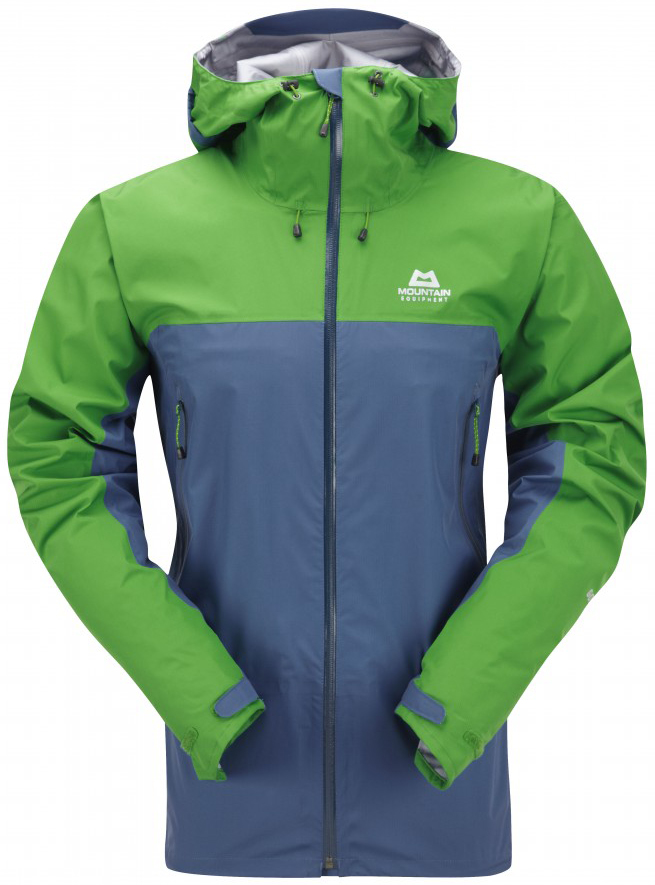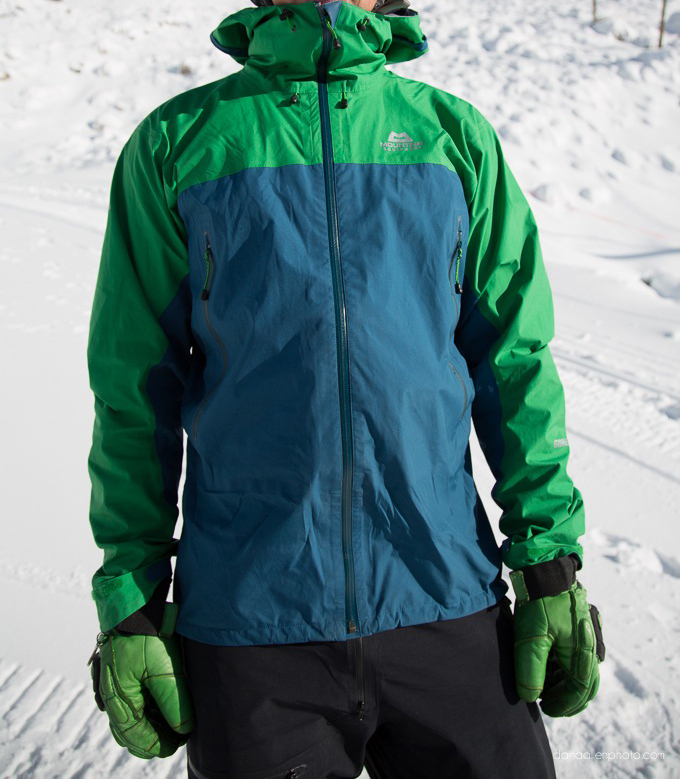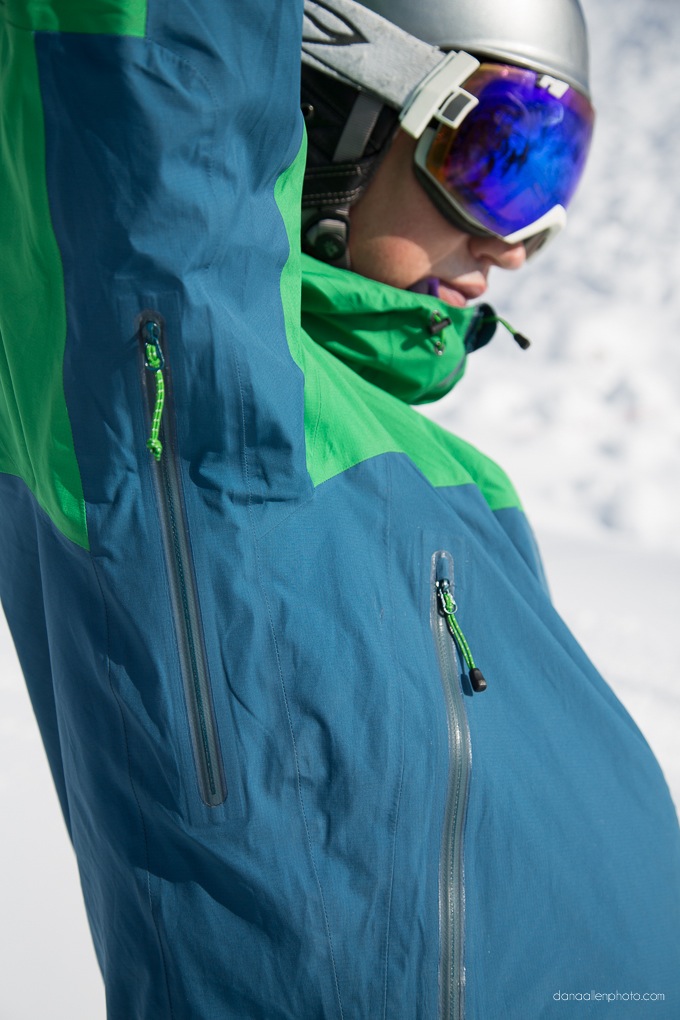
Mountain Equipment Firefox Jacket
Size Tested: Large
Manufacturer’s Stated Weight: 350 grams
Color: Nautilus Gecko
Front Zipper Length: 29.9″
Features:
- Fabric: Gore-Tex Active (20 Denier on body / 30 on arms & shoulders)
- Fit: Alpine
- Fully adjustable hood
- 2 ventilated pockets with bonded mesh pocket bags
- Underarm pit zips
Adjustable cuffs and dual tether hem drawcords
Reviewer: 6’, 190 lbs., typically wear size large Jackets and pants, 32-33 inch waist.
Test Locations: Canterbury Club Fields (Craigieburn, Olympus, Temple Basin), Mt Hutt Helicopter Skiing, Treble Cone Ski Area, New Zealand; Chugach, Kenai, Neacola, Talkeetna Mountain Ranges, Chugach National Forest, Kenai Peninsula, Kodiak Island, Alaska.
Days tested: 80+
[Editor’s Note: Reviewer Paul Forward has now tested the Firefox jacket for more than 80 days over the last two years. For a long-term update, he’s added a few new details to this review that speak to the Firefox’s year-round performance as well as its durability.]
Mountain Equipment’s describes the Firefox as “an exceptionally breathable waterproof shell that provides serious protection for any fast moving mountain activity.” After a wearing it over 80 days in the last two years, during both summer and winter activities, I’d say this is an accurate statement.
The Firefox can easily be used year-round as your only waterproof / breathable shell, and I’ve said similar things about the Arc’teryx Rush jacket. It’s not simply a toss-up between the Firefox and the Rush, however.
This review teases out the most important differences between the two shells, will help you decide which is better suited for you, and make you better informed about jackets in general.
Fit
The Firefox is designed as a multi-season shell, and its fit is like that of an alpinist climbing piece with a more trim cut through the chest, torso and arms than a roomier, freeride-inspired ski shell.
Its fit is slimmer throughout than more ski-specific shells like the Arcteryx Rush, Patagonia Refugitive, or the Sweet Protection Supernaut, for example.

Even so, I had no problems wearing the Firefox while skiing in the Canterbury club fields of New Zealand, and the jacket has also worked perfectly for me over two summers in Alaska. I found the jacket to be loose enough to accommodate a midweight puffy jacket underneath, but also trim enough to wear only a thin wool baselayer comfortably.
I did not experience any range of motion issues while my arms were extended above my head while swinging an ice axe or climbing over a cornice. If I wore gloves with a short, low-profile cuff, my wrists would sometimes be slightly exposed during these types of maneuvers, but never so much as to be a problem.
The length of the Firefox’s hem was never an issue while wearing bibs in New Zealand, though again, it is shorter than your typical ski-specific shell; so at times, when wearing ski pants rather than bibs while skiing deep powder, I felt like an extra couple of inches of length would have been nice to have, though not absolutely needed. I should say that I do not have a particularly long torso (about 20 inches from C5 to the top of my iliac crests). I haven’t used a jacket that I thought was too long for me—I always appreciate a little extra material at the back of the jacket to keep out snow and water if the jacket starts creeping up under my backpack.
With that said, for general summer use on Kodiak Island (mountain biking or hiking), the Firefox’s trimmer, slimmer fit was just about perfect
Notable Features of the Firefox
The hood on the Firefox also seems to be designed for year-round use. It did not accommodate a ski helmet quite as well as the Rush (which has one of the best-fitting hoods I’ve ever used), as it provides bit less facial coverage and can slip back a little while skiing. But while wearing any kind of hat, the Firefox’s hood works fine. In general the hood adjustments are effective and intuitive, and create a good fit without obstructing my field of view.

The Firefox has underarm pit zips, as well as two chest pockets that have mesh pocket bags, so you can also open them for added ventilation.
The hook and loop straps on the jacket’s cuffs are thinner than those found on the Arc’teryx Rush, so they aren’t as strong when tightened over gloves. The cuff diameter is also a bit smaller, and while it has no problem fitting over shorter gloves like my Hestra Vertical Cut Freeride, the larger cuff diameter on other, more ski-specific shells makes wearing gloves with larger cuffs a bit easier and more comfortable.

Paul, Can you comment on the overall quality differences between these mtn equipment pieces and comparable arcteryx items?
Hi Blister.
Very interesting review and comparison! I saw you mentioned the Sweet Protection Supernaut jacket in the fit section of this review. Is this a jacket which you are reviewing or have had much time in as I have recently had my eye on it so would be interested in hearing more about it!
Many thanks,
Jamie
Thanks for the review, Blister!
I’ve skied in the backcountry with this jacket for 10 days, and I’ve used it while resort skiing and snow shoveling too.
The days have ranged from freezing rain in Whistler to heavy snow in Japan.
I’d affirm that this jacket is super packable, and a great storm shell for BC skiing.
However, I’ve found a couple small caveats with the piece.
First, the main zip and pit zippers are quite tiny and hard to reach with gloves on.
Second, I’ve already put holes in the sleeves due to the very soft Gore fabric.
Third, the velcro on the wrist cuffs started to pull out after about a week’s use.
My verdict: use it for ski touring and rain gear, but not much else.